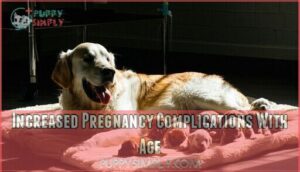This site is supported by our readers. We may earn a commission, at no cost to you, if you purchase through links.

Your dog’s breeding years have a natural expiration date, and missing the warning signs can put both mother and puppies at serious risk. While small breeds might safely produce litters until age seven, giant breeds often need to retire by five.
The timing depends on breed size, health history, and physical condition. Recognizing when your dog has reached the end of their breeding career protects them from life-threatening complications while ensuring healthier puppies.
Table Of Contents
- Key Takeaways
- When is a Dog Too Old to Breed?
- How Age Affects Dog Fertility and Health
- Responsible Breeding Decisions for Older Dogs
- Breed-Specific Breeding Guidelines
- What to Do if a Senior Dog Gets Pregnant
- Frequently Asked Questions (FAQs)
- What Are the Recommended Limits for Breedings in a Female Dog’s Lifetime?
- What Are the Risks of Breeding at Older Ages?
- What Signs Indicate a Decline in Male Fertility?
- How Can I Get Veterinary Guidance on Appropriate Breeding Age?
- What Should I Do if My Senior Dog Gets Pregnant?
- Is it safe for a 10 year old dog to have puppies?
- Is it okay to breed a 7 year old dog?
- At what age are dogs no longer fertile?
- What happens if a 7 year old dog gets pregnant?
- What are the recommended limits for breedings in a female dog’s lifetime?
- Conclusion
Key Takeaways
- Female dogs should typically stop breeding between ages 5-7, while males can breed safely until around 8 years old, with giant breeds retiring earlier (around age 5) and small breeds potentially continuing longer due to significant differences in how size affects reproductive aging.
- Older dogs face dramatically increased pregnancy risks, including a 21% chance of difficult labor requiring emergency surgery, nearly double the neonatal mortality rate, and a 50% tumor prevalence, making continued breeding after prime years genuinely life-threatening.
- Warning signs that your dog should retire from breeding include difficulty delivering puppies, prolonged recovery between litters, reduced litter sizes, irregular heat cycles, and age-related health problems like arthritis or heart issues that signal the body can’t safely handle pregnancy anymore.
- Responsible breeding decisions require thorough health screenings (cardiac evaluation, joint assessments, genetic testing), limiting females to 4-6 lifetime litters with at least one year between pregnancies, and consulting veterinarians rather than pushing dogs beyond their natural reproductive limits.
When is a Dog Too Old to Breed?
Knowing when your dog is too old to breed isn’t always straightforward. Age limits vary based on factors like sex, breed size, and individual health.
Let’s look at the key guidelines that help you make safe, responsible breeding decisions.
Typical Breeding Age for Male and Female Dogs
Most female dogs hit their ideal breeding age between 2 and 5 years, when their reproductive health factors are strongest. Males generally maintain peak fertility from 2 to 8 years, though sperm quality gradually declines.
Age-related changes affect both sexes differently—females face more sudden shifts after age 5, while male dog breeding age extends longer. Understanding these breeding lifespan variations helps you make safer decisions for your dog’s reproductive health.
Breed and Size Differences in Reproductive Lifespan
Size plays a bigger role in reproductive aging than many people realize. Your dog’s body size directly impacts how long they can safely breed, with smaller breeds often staying fertile years longer than their giant counterparts.
Here’s how breed size affects reproductive lifespan:
- Giant breeds (like Great Danes) often retire from breeding by age 5, producing 6-8 puppies per litter during their prime.
- Large breeds live about 11.5 years on average, with shorter breeding windows than smaller dogs.
- Small breeds maintain fertility longer, usually retiring around age 7, though they produce smaller litters (1-5 puppies).
- Toy breeds (like Yorkshire Terriers) have the longest lifespans at 12.7 years but face unique pregnancy complications as older bitches.
Large breeds face higher inbreeding effects and breed-specific risks due to historical breeding practices. Factors such as size and facial structure impact a dog’s life expectancy. They also show more dramatic litter size variation with age compared to toy breeds, making breed retirement age recommendations essential for preventing age-related problems and pregnancy complications.
Signs Your Dog Should Stop Breeding
Your dog’s body will often tell you when it’s time to retire from breeding, but catching these signals early protects both parent and future puppies. Watch for behavioral changes like anxiety during heat cycles or disinterest in mating. Health complications such as persistent health issues, prolonged recovery between litters, or reduced litter size indicate your dog’s reproductive lifespan may be ending.
| Physical Signs | Reproductive Signs |
|---|---|
| Difficulty delivering puppies | Reduced litter size over consecutive breedings |
| Prolonged recovery after whelping | Irregular heat cycles or skipped seasons |
| Age-related problems (arthritis, heart issues) | Increased stillbirths or weak puppies |
Ethical considerations demand that you prioritize your dog’s wellbeing over breeding goals, especially when older dogs show these warning signs.
Risks of Breeding Older Dogs
When breeding continues past a dog’s prime years, you’re gambling with serious consequences that go far beyond an unsuccessful mating. Older dogs face dystocia likelihood jumping to 21% in senior females, often requiring emergency surgery. Neonatal mortality rates nearly double, while sperm abnormalities and genetic mutations accumulate with age.
Health complications like tumors prevalence approaching 50% and declining immune function make potential breeding complications life-threatening for both parents and offspring. It’s essential to conduct thorough pre-breeding health checks to mitigate these risks.
How Age Affects Dog Fertility and Health
As your dog ages, fertility naturally declines, and breeding becomes riskier for both parents and puppies. Female dogs face higher pregnancy complications, while male dogs produce lower-quality sperm as they get older.
Understanding these age-related changes helps you make safer breeding decisions and protect your dog’s health.
Declining Fertility in Female Dogs
As female dogs reach their senior years, their bodies naturally shift away from peak reproductive capacity. This decline in canine fertility affects several important factors:
- Litter size decreases – Older dogs usually produce fewer puppies per pregnancy
- Conception rates drop – It becomes harder for female dogs to get pregnant successfully
- Pregnancy risks increase – Complications during gestation and delivery become more common
- Hormonal changes occur – Reproductive cycles may become irregular or less predictable
These genetic factors and changes in reproductive health mean that breeding older dogs requires careful evaluation of each individual’s condition and reproductive lifespan.
Sperm Quality and Male Dog Aging
While female fertility gets most of the attention, male dogs also experience a gradual decline in sperm quality as they age. Sperm motility decreases, meaning those swimmers don’t move as vigorously. You’ll also see more genetic defects in older stud dog health, which affects breeding frequency success.
That’s why semen analysis becomes essential for aging male dogs—it helps you monitor their reproductive lifespan and make informed decisions about continuing their breeding careers.
Increased Pregnancy Complications With Age
As your dog ages, pregnancy becomes like running a marathon without proper training—the body just isn’t equipped for the challenge anymore. Older dogs face serious gestation risks, including dystocia (difficult labor), where weakened muscles can’t push puppies through the birth canal effectively.
These age-related problems lead to more stillborn puppies, genetic issues in surviving litters, and whelping difficulties that often require emergency C-sections. Beyond the physical complications, ethical concerns arise when breeding older dogs who may not survive delivery or recovery.
Health Screenings for Older Breeding Dogs
Before you even consider breeding your older dog, a thorough veterinary exam isn’t optional—it’s the safety net that could save her life. Health screenings should include cardiac evaluation, joint health assessments, cancer screening, and testing for hormonal imbalance or genetic predispositions.
These veterinary checkups help you understand breeding dog health considerations, making sure your older dog can endure pregnancy safely.
Responsible Breeding Decisions for Older Dogs
Deciding whether your older dog should continue breeding isn’t something you should take lightly. You’ll need to look at several important factors to make the right choice for your dog’s health and well-being.
Let’s walk through the key considerations that responsible breeders use when evaluating older dogs.
Evaluating Your Dog’s Health and Temperament
Your dog’s overall health and personality matter just as much as the number on their birth certificate when making breeding decisions. A thorough health evaluation should include genetic screening for breed predispositions, along with health tests for hip dysplasia, eye conditions, and heart function.
Temperament assessment is equally important—you want to pass along stable behavioral traits, not anxiety or aggression.
Considering Number and Timing of Previous Litters
Each pregnancy takes a toll on a female dog’s body, so tracking how many litters she’s had—and how much recovery time she’s gotten between them—helps you make safer breeding choices. Here’s what your dog’s reproductive history reveals:
- Litter frequency shows whether she’s had proper inter-litter intervals for full recovery.
- Previous complications during whelping signal increased risks in older dogs.
- Breeding fatigue accumulates after multiple pregnancies, even with adequate rest periods.
- Ideal litters for most breeds rarely exceed four to six over a lifetime.
Consulting Veterinarians and Breeding Experts
Professional guidance makes all the difference when you’re deciding whether your dog should have another litter, especially as she ages. Your veterinarian can perform a reproductive health assessment and identify risks you might miss.
Reproduction specialists offer genetic counseling and second opinions on ethical considerations surrounding older breeding dogs.
Expert advice on dog breeding considers both the health of breeding dogs and whether continuing is truly in your dog’s best interest.
Breed-Specific Breeding Guidelines
Not all dogs age the same way in terms of breeding. A Yorkshire Terrier’s reproductive timeline looks very different from an Akita’s, and understanding these breed-specific differences can help you make safer decisions.
Let’s look at how size, breed standards, and individual breed traits affect when breeding should stop.
Large Vs. Small Breed Reproductive Ages
Size matters regarding how long a dog can safely breed, with smaller dogs often staying fertile years longer than their larger counterparts. This size-fertility link reflects differences in maturity, gestation periods, and overall lifespan variation between breeds.
- Small breeds can breed safely until 7-8 years old
- Large breeds should stop breeding by age 5-6
- Giant breeds face breed-specific risks earlier, around 4-5 years
- Litter size impact varies, with larger dogs experiencing more physical strain
Breed Standards and Ideal Breeding Age
Beyond size alone, kennel club guidelines and veterinary recommendations work together to define safe breeding age windows. The American Kennel Club only registers litters from females bred before 12 years and males at least 7 months old at mating.
Most vets recommend breeding females between 2 and 5 years for best health, while males reach full fertility around 12 to 15 months. Breeding outside these age limits increases genetic risk factors for both parents and puppies, which is why breed standards emphasize proper timing.
Special Considerations for Popular Breeds (e.g., Yorkies, Akitas)
Some breeds carry unique reproductive timelines that don’t follow the general rules, making it essential to understand your dog’s specific needs before planning a litter. Yorkies face pelvic area calcification after their first heat cycle, so breeding female Yorkies early prevents age-related problems during whelping.
Akitas have shorter reproductive windows due to their large breed genetics and reduced lifespan, making ethical concerns about breeding older dogs particularly important for these muscular companions.
What to Do if a Senior Dog Gets Pregnant
If your senior dog gets pregnant unexpectedly, quick action matters. You’ll need to provide extra care throughout her pregnancy to protect both her health and her puppies’ development.
Here’s what to focus on to give her the best chance at a safe pregnancy and delivery.
Veterinary Care and Monitoring
When a senior dog becomes pregnant, you’ll need to increase veterinary care considerably to protect both mother and puppies. Your veterinarian will create a monitoring schedule that covers the unique challenges older dogs face during pregnancy.
Here’s what all-inclusive veterinary care for your senior pregnant dog includes:
- Pre-breeding exam and regular check-ups every 2–3 weeks to track maternal health and detect complications early
- Ultrasound from day 25 and radiographs after day 45 for monitoring fetal health and counting puppies
- Repeated bloodwork to watch for anemia, infections, and metabolic changes like calcium or glucose imbalances
- Emergency delivery plans since senior dogs face up to seven times higher risk of needing cesarean sections
Your veterinarian will also advise you on temperature monitoring in the final week and make sure you’re prepared for potential delivery complications.
Nutrition and Prenatal Support
Proper nutrition becomes your most powerful tool for assisting a senior dog through pregnancy and protecting her from the increased strain on her aging body. Prenatal vitamins and supplementation options address her specific dietary needs, and keeping fresh water available reinforces hydration importance throughout pregnancy for ideal dog health.
You’ll need to switch to high-quality puppy food rich in protein and calcium by week five, while your veterinarian monitors her weight management closely.
Preparing for Whelping and Postnatal Care
Setting up a safe, comfortable whelping area well before your dog’s due date gives you the best chance of managing any complications that often arise when older mothers deliver puppies. You’ll want to prepare a whelping box in a quiet, warm space where she can rest undisturbed.
Watch for labor signs like restlessness and panting, and keep your vet’s number handy since senior dogs face higher c-section risks with each litter.
Ensuring Puppy and Mother Health
Once your senior dog delivers, you’ll need to monitor both mom and her puppies closely during those critical first weeks to catch any health issues before they become serious. Check these key areas daily:
- Puppy weight gain – Each puppy should gain weight steadily, signaling healthy development and adequate milk supply.
- Mother’s appetite and energy – Watch for signs of infection or exhaustion that require veterinarian consultation.
- Nursing behavior – Make certain all puppies latch properly and mom doesn’t show pain during feeding.
- Whelping complications like retained placentas or excessive bleeding need immediate attention.
- Puppy development milestones – Eyes opening, movement patterns, and vocalization indicate proper reproductive health outcomes.
Schedule postnatal support visits with your vet to address any complications early.
Frequently Asked Questions (FAQs)
What Are the Recommended Limits for Breedings in a Female Dog’s Lifetime?
Most responsible breeders recommend limiting female dogs to four to six litters over their lifetime, spacing pregnancies at least one year apart to protect their health and guarantee proper recovery between births.
What Are the Risks of Breeding at Older Ages?
Breeding older dogs raises serious concerns about dystocia, whelping complications, and maternal mortality. Age-related problems increase puppy viability risks, while genetic disorders become harder to manage.
Ethical concerns grow as complications threaten both mother and puppies.
What Signs Indicate a Decline in Male Fertility?
You’ll notice your male dog’s fertility decline through reduced sperm motility and semen volume, decreased libido, smaller testicle size, and lower breeding success rates. Age affects canine fertility gradually, making reproductive health checks essential for older male dogs.
How Can I Get Veterinary Guidance on Appropriate Breeding Age?
Start by scheduling a thorough pre-breeding exam with your veterinarian to discuss age considerations for breeding and review your dog’s complete health history.
Reproductive specialists can provide fertility testing, genetic counseling, and veterinary advice for breeding that considers ethical considerations unique to your dog’s age and breed.
What Should I Do if My Senior Dog Gets Pregnant?
If your older dog becomes pregnant unexpectedly, it’s a blessing and a burden all at once.
Contact your veterinarian immediately to discuss emergency planning, potential termination options if health risks are severe, and genetic screening to assess complications and age-related problems inherent in breeding older dogs.
Is it safe for a 10 year old dog to have puppies?
No, it’s generally not safe for a 10-year-old dog to have puppies. At this age, senior pregnancy risks increase considerably, including complications like difficult labor, genetic defect likelihood, and poor puppy health outcomes.
Ethical breeding limits usually end much earlier to protect both mother and offspring.
Is it okay to breed a 7 year old dog?
At what age do the risks of breeding older dogs begin to outweigh the benefits? For a 7-year-old dog, breeding is generally at the upper limit, especially for females.
This falls within the 5 to 7-year range where reproductive lifespan usually ends due to declining canine fertility and increased genetic risks.
At what age are dogs no longer fertile?
Female dogs usually lose fertility between 5 and 7 years old, though some remain fertile into their early teens. Male dogs can stay fertile longer—often until 10 years or older—but sperm viability decreases with age.
Reproductive lifespan varies by breed size, with smaller dogs maintaining fertility longer than large breeds.
What happens if a 7 year old dog gets pregnant?
A seven-year-old dog’s pregnancy carries higher risks, including complications like difficult labor, smaller litters, and age-related health problems.
Your veterinarian should monitor her closely throughout pregnancy to address any issues and guarantee both mother and puppy viability through proper care and owner responsibility.
What are the recommended limits for breedings in a female dog’s lifetime?
Most veterinarians recommend limiting female dogs to four to six litters over their lifetime, with adequate spacing between pregnancies. This approach protects canine reproduction health while maintaining genetic diversity.
Responsible breeding considers each dog’s reproductive history, breed variations, and the cumulative health impact of multiple litters on the reproductive lifespan of dogs.
Conclusion
Think of breeding like a candle burning at both ends—eventually, the flame goes out. Knowing when a dog is too old to breed protects your companion from preventable suffering while giving future puppies their best start.
Age isn’t just a number; it’s your dog’s body sending clear signals about what it can safely manage. Pay attention to those messages.
Your dog trusted you with their whole life—honoring their limits in their senior years is how you return that trust.
- https://florenceah.com/dog-breeding-age-guidelines/
- https://www.akc.org/breeder-programs/breeder-education/akcs-guide-responsible-dog-breeding/
- https://www.americanbreeder.com/resources/american-breeder-blog/dogs/breeding-senior-dogs-safely
- https://forum.champdogs.co.uk/topic_show.pl?tid=121357
- https://akcchf.org/













